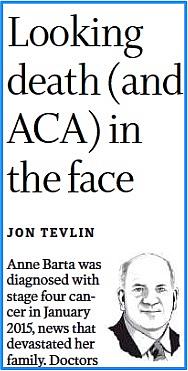Piling on the Affordable Care Act while giving private insurers a free pass

Photo: Joe Raedle/Getty Images
Right off the top, let me be clear that I’m no apologist for the Affordable Care Act. Its imperfections are quite clear to me. However, when I see a news story or newspaper column pile on out of bounds, I’m going to throw a flag for unnecessary roughness.
And so, the flag is thrown for a (Minneapolis) Star Tribune column under the headline: “Looking death (and ACA) in the face.”
That’s the kind of headline that will draw me in any time. And, if that’s what headlines are supposed to do, it worked in my case. I wonder how many other readers were drawn in by it.

I know that at least one other reader — bioethicist Steve Miles, MD — had much the same reaction to the piece that followed as I did.
“This has zero to do with the ACA,” Miles told me.
Why was ACA – the Affordable Care Act – in the headline?
The heart of the story seemed to be that a woman with stage four cancer who was being treated at the Mayo Clinic recently learned that:
“Mayo will soon be considered outside the network of their provider, Blue Cross Blue Shield. To continue to get the care at Mayo that they believe is keeping Anne alive, the Bartas would have to re-enroll in a plan that has no cap on out-of-pocket expenses. The coinsurance would be 50 percent after the deductible is met. John has estimated his wife’s care could be $300,000 next year, meaning he would have to come up with $150,000 a year.
The Bartas seem to have done everything right. They always bought the best health care plan while working, and did so again when John lost his job. The industry has changed on him, and now the Bartas may have to decide whether to continue treatment at the risk of quickly depleting the family retirement savings.”
The only mention of the ACA in the entire piece was this:
“Eileen Smith, director of communications for the Minnesota Council of Health Plans, said that before passage of the ACA, the Bartas would have been able to buy a policy through the Minnesota Comprehensive Health Association. The state’s high-risk pool, where people with preexisting conditions who were turned down by insurance companies could buy a policy, allowed patients to go to the hospital of their choice.”
Dr. Miles told me there were options that the column didn’t explore:
“If Mayo’s price is too high for insurance, they should ask for a concierge option in the ACA where elite or highly sought high-charge providers can be covered out of network. This could be done two ways: 1) an out of network fee within Blue Cross Blue Shield or 2) Having Blue pay Mayo the same rate it pays other providers and then having Mayo bill the patient the rest. A third option would be government price controls on Mayo.”
Instead of the ACA in the Star Tribune’s headline, why not Blue Cross Blue Shield? Or Mayo?
Lynn Blewett, PhD, Mayo Professor of Health Policy and Management at the University of Minnesota School of Public Health also responded to my request for analysis:
“The ACA has made it possible for this family to get coverage without being turned down by private insurance – there are no longer pre-existing conditions and no under-writing–that is doing assessments to figure out who is sick and then sending them to the Minnesota Comprehensive Health Association. But most plans now are no longer offering Mayo because of its higher costs.”
Blewett also wrote that this sentence in the column was inaccurate unless you add the bold italics she added – “To continue to get the care at Mayo that they believe is keeping Anne alive, the Bartas would have to re-enroll in a plan that has no cap on out-of-pocket expenses for non-network providers.” She wrote: “All individual market plans are required to have caps on out-of-pocket spending – they do not have to have caps on the spending for “out-of-network.”
Why not more headlines and stories like this one by Salon.com?
Excerpts:
“While Americans continue to be hammered by rising health care costs, and while congressional lawmakers (with their taxpayer-subsidized health care) do nothing to lower cost of pharmaceuticals and medical care, one group is reaping a windfall in profit: health insurance companies and their investors.
A Salon analysis of regulatory filings found that the top five health insurers — UnitedHealth, Anthem, Aetna, Humana and Cigna — have doled out nearly $30 billion in stock buybacks and dividends from 2013 to 2015. (The Supreme Court ruled in factor of the Affordable Care Act in 2012.)
Meanwhile, the increase in customers that these health insurers received under ACA has helped raise the stock prices of the top five insurers — some 80 percent for Anthem and 165 percent for Aetna since the high court ruled on June 28, 2012 that Obamacare was constitutional.
…Aetna’s earnings report ($734 million in profit on $15.8 billion in revenue for the three months that ended Sept. 30) came a week after UnitedHealth reported a 12 percent jump in revenue to $46.3 billion for the three months that ended Sept. 30 compared with the same period the previous year. (Anthem, Cigna and Humana will report their latest quarterly earnings next week.)”
Somebody needs to be the referee on some of the cheap shots flying around on an uneven playing field. Single anecdote “let’s blame the ACA for something else” stories fail to reflect the big picture of people helped by the legislation. It’s ironic that the next day, the same Star Tribune published a story, “Uncompensated care costs at Minnesota hospitals plunge since health law.” Money quotes:
“…with the health law apparently helping more Minnesotans cover their medical bills. …. A reduction in uncompensated care is important… because ‘it’s likely that fewer people are rationing their own health care or experiencing fragmentation in care.’ “
Not quite the picture we got in a headline that framed one person’s story as “Looking death (and the ACA) in the face.”
This article was originally posted on HealthNewsReview.org and is republished here with permission. Gary Schwitzer is HealthNewsReview.org's publisher. He tweets at @garyschwitzer.


